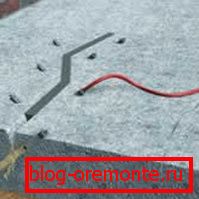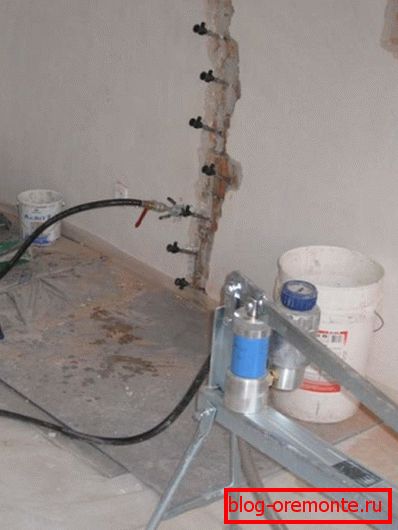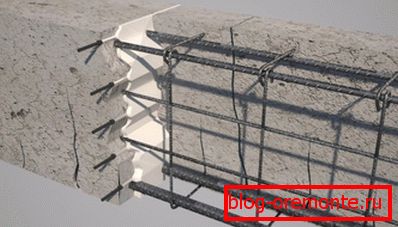Injection of concrete: restoration of monolithic structures
Injection of concrete is one of the most modern and efficient technologies, allowing to repair defective concrete structures of buildings and structures. Its essence consists in filling the voids appearing in the monolith with the help of specially developed polymer compositions injected under pressure.
As a result of this operation, which, with proper skill and ability, can be done with your own hands, there is no need for a major reconstruction of the damaged surface.

Applicable materials
The mixtures used to fill the cracks are made on the basis of:
- epoxy resins;
- polymer cement compositions;
- polyurethane.
Injection of concrete should be carried out with a solution having a weak viscosity and high penetrating power, regardless of the size of the damage and the ambient temperature.
We list the main properties of the compositions for injection:
- reduced viscosity;
- possibility of use at very low and high ambient temperatures;
- minimal shrinkage during curing;
- high level of adhesion to various materials, including metal reinforcement;
- aging resistance;
- no corrosive properties.
Note! The choice of injection material must be made prior to the commencement of work, so that the necessary equipment can be selected.
Epoxy resins
Они используются для заполнения трещин в различных бетонных основаниях, к прочности которых предъявляются повышенные требования. Epoxy resins могут проникать в микроскопические дефекты, толщина которых составляет менее 0,5 мм.
In this case, the filling density will be maximum, regardless of the extent of damage. Due to the measures taken, the concrete structure will restore its bearing capacity and structural strength.
Epoxy resins незаменимы также для обработки поверхностных трещин и сколов.

Grade materials
Their use is justified in cases where the amount of damage is large enough, which makes the use of epoxy resin too expensive. They make it possible to increase the density of concrete products and strengthen both new concrete structures and elements of old buildings during restoration.
During injection, a special cement slurry is supplied under pressure, which allows it to penetrate into all cavities and pores, some of which may be hidden.
This type of treatment is used to strengthen old buildings with the help of columns. In order for the new reinforced concrete structure to be fully integrated into the structure of the building, an injection is made by which the support will be connected to other architectural elements.
The described method is indispensable for the restoration of old concrete foundations, which have not only cracks resulting from shrinkage and when exposed to the weight of the building, but also fragmentary damage.

Waterproofing compounds
In order to protect structures from water penetration, polyurethane is used, which has waterproofing properties.
It is often used for the following types of work:
- filling seams and joints between monolithic concrete parts;
- handling wet openings;
- insulation holes and cracks in water and sewer networks.
Stages of work
Surface preparation
The instruction, which regulates the work on the injection of concrete, says that before the introduction of sealing resins, it is necessary to properly prepare the surface of the wall or another reinforced concrete structure.
For this you need:
- Using a perforator, drill holes along the cracks that appear. They must be staggered, directed towards the defect and reach the cavities and voids inside the monolith.
- Packers must be inserted into the holes. They are special tubes to which equipment for the injection of concrete is connected with the help of special hoses.
- With the help of the pump, the cementing mixture is fed through the pipes. If the holes and packers in them were placed correctly, the composition will evenly and tightly fill all voids, restoring the integrity of the monolithic plate.

Note! The pressure of the supplied epoxy or polyurethane resin depends on the viscosity of the material and the size of the crack. If you let in too much of the compound, it will widen the crack, breaking the strength of the concrete monolith.
Features of filling cracks
The simplest option is when a defect in concrete does not exceed 0.5 mm, and there is no rust on the metal parts of the reinforced concrete structure. In this case, even if manual concrete injectors are used, the filling of voids occurs quickly and without additional efforts.
When visual inspection revealed corrosion and delamination of the concrete slab, remove all excess crumbled material and clean the reinforcement with a grinder.
Do not neglect this stage of work, the cost of the error is too high: the injection solution does not harden correctly, and the crack will increase even more.

Depending on the location of the defect, several filling schemes are used:
- Vertical. In this case, the injection occurs from the lowest point to the upper extremity.
- Horizontal Filling with cementitious composition can be carried out simultaneously from two sides, from the center to the edges and from left to right.
- Ceiling. The work is carried out similarly to the previous scheme. Epoxy resin, due to its viscosity, will not leak out of the holes.
After the end of the filling, the tubes are disconnected, and the packers are closed with special traffic jams. The restoration site is protected by a special film, which is left for the entire time the composition hardens. It lasts from 2 days to a week.
The final stage is the application of an insulating and decorative layer, which makes it possible to hide all traces of the repairs made.

Nuances of waterproofing works
If the purpose of injection is waterproofing, the work is done in two stages:
- First, polyurethane is pumped into the cracks., which blocks the flow of moisture and forms a porous waterproofing structure;
- after curing of the polyurethane, epoxy resin is fed through the packersfilling the voids and pores of polyurethane and forming a strong and cohesive structure.
Conclusion
Before choosing one method of injection or another, one should be aware of how the structure was used and will be used, and why the destruction occurred. This will allow you to develop the correct scheme of the procedure and select the material you need in specific conditions.
Learn more about the various ways to eliminate defects in concrete structures will help the video in this article.